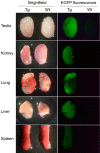Transgenic mouse offspring generated by ROSI
- PMID: 26498042
- PMCID: PMC4768777
- DOI: 10.1262/jrd.2015-105
Transgenic mouse offspring generated by ROSI
Abstract
The production of transgenic animals is an important tool for experimental and applied biology. Over the years, many approaches for the production of transgenic animals have been tried, including pronuclear microinjection, sperm-mediated gene transfer, transfection of male germ cells, somatic cell nuclear transfer and the use of lentiviral vectors. In the present study, we developed a new transgene delivery approach, and we report for the first time the production of transgenic animals by co-injection of DNA and round spermatid nuclei into non-fertilized mouse oocytes (ROSI). The transgene used was a construct containing the human CMV immediate early promoter and the enhanced GFP gene. With this procedure, 12% of the live offspring we obtained carried the transgene. This efficiency of transgenic production by ROSI was similar to the efficiency by pronuclear injection or intracytoplasmic injection of male gamete nuclei (ICSI). However, ICSI required fewer embryos to produce the same number of transgenic animals. The expression of Egfp mRNA and fluorescence of EGFP were found in the majority of the organs examined in 4 transgenic lines generated by ROSI. Tissue morphology and transgene expression were not distinguishable between transgenic animals produced by ROSI or pronuclear injection. Furthermore, our results are of particular interest because they indicate that the transgene incorporation mediated by intracytoplasmic injection of male gamete nuclei is not an exclusive property of mature sperm cell nuclei with compact chromatin but it can be accomplished with immature sperm cell nuclei with decondensed chromatin as well. The present study also provides alternative procedures for transgene delivery into embryos or reconstituted oocytes.
Figures


References
-
- Celebi C, Guillaudeux T, Auvray P, Vallet-Erdtmann V, Jégou B. The making of “transgenic spermatozoa”. Biol Reprod 2003; 68: 1477–1483. - PubMed
-
- Chan AW. Transgenic animals: current and alternative strategies. Cloning 1999; 1: 25–46. - PubMed
-
- Wall RJ. New gene transfer methods. Theriogenology 2002; 57: 189–201. - PubMed
-
- Gutiérrez-Adán A, Maga EA, Meade H, Shoemaker CF, Medrano JF, Anderson GB, Murray JD. Alterations of the physical characteristics of milk from transgenic mice producing bovine kappa-casein. J Dairy Sci 1996; 79: 791–799. - PubMed
-
- Pintado B, Gutiérrez-Adán A. Transgenesis in large domestic species: future development for milk modification. Reprod Nutr Dev 1999; 39: 535–544. - PubMed
Publication types
MeSH terms
Substances
LinkOut - more resources
Full Text Sources
Other Literature Sources

